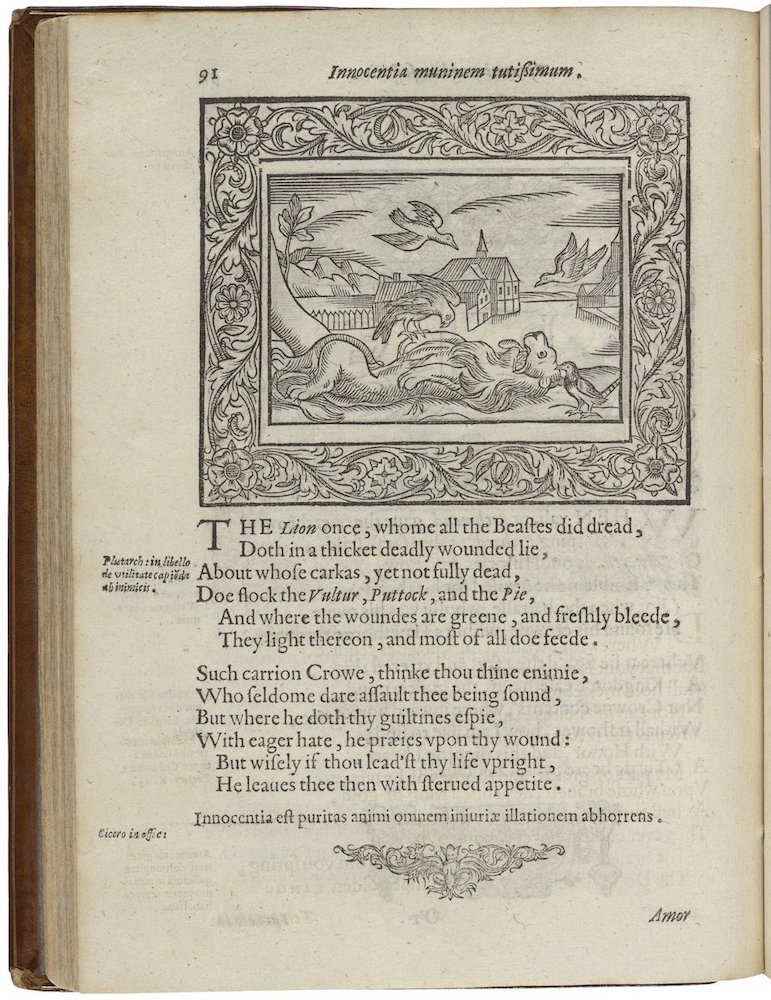Eurasian Magpie (Pica pica)
Painting by Missy Dunaway. Created with acrylic ink on paper. 30x22 inches (76x56 cm)
Painting Key
Fauna: 3 Eurasian magpies (Pica pica), 5 maggots
Flora: Various leaves native to the British Isles: Downy Birch (Betula pubescens), European hornbeam (Carpinus betulus), English oak (Quercus robur), Small-leaved lime (Tilia cordata), Common ash (Fraxinus excelsior), Whitebeam (Sorbus aria), Rowan (Sorbus aucuparia), Wild service tree (Sorbus torminalis), Black poplar (Populus nigra), Violet willow (Salix daphnoides), Bay willow (Salix pentandra), Almond willow (Salix triandra), Field maple (Acer campestre)
Objects: 7 Eurasian magpie eggs, 9 Eurasian magpie feathers, 2 17th-century gold rings
Literary Guide
Occurrences in text: 4
Plays: Henry IV Part 2, Henry VI Part 3, Macbeth, The Merry Wives of Windsor
Name as it appears in the text: “pie,” “maggot pie”
Shakespeare’s corvids include the raven, crow, rook, jackdaw, jay, and magpie. With the exception of the blue jay, these birds often appear together in ominous flocks to plunder the dead. The magpie was thought to be possessed by the devil and channeled his evil words while chattering, an idea suggested by King Henry in Henry VI, Part 3.[1]
Henry VI, Part 3 (Act V, Scene 6, Line 45)
KING HENRY: The owl shrieked at thy birth, an evil sign;
The night-crow cried, aboding luckless time;
Dogs howled, and hideous tempest shook down trees;
The raven rooked her on the chimney’s top;
And chatt’ring pies in dismal discords sung;
Thy mother felt more than a mother’s pain,
And yet brought forth less than a mother’s hope:
To wit, an indigested and deformèd lump,
Not like the fruit of such a goodly tree.
A vulture, puttock, and magpie all feed on a deceased lion in this illustration by Henry Peacham (Minerua Britanna, 1612). The accompanying adage asserts that carrion birds will only eat upon guilty flesh. If one leads a “life upright,” the birds will move along without satiating their appetite. Folger Shakespeare Library
As a representative of the devil, it is fitting that the magpie appears in Macbeth, a play known for witches and cursed prophecies.
Macbeth (Act III, Scene 4, Line 151)
MACBETH: It will have blood, they say; blood will have blood.
Stones have been known to move, and trees to
speak.
Augurs and understood relations have
By maggot pies and choughs and rooks brought
forth
The secret’st man of blood.—What is the night?
Here, Macbeth describes the magpie as a “maggot pie.” This description reveals how the magpie got its name. “Magot” is a French word for a hoard of secreted money.[2] This title may have been given to the magpie for its tendency to hide things. Or “maggot” could be referring to the magpie’s favorite food.
Excluding the vibrant blue jay, my challenge is to make Shakespeare’s flock of black, threatening corvids distinctive in their respective paintings. The magpie is the only “pied” corvid from the flock, which sets it apart. “Pied” describes something as having two or more colors. For the magpie, this refers to its black and white feathers with a surprising splash of cobalt on its secondary flight feathers. This may explain why the word “pie” also describes the food dish, which is a mixture of various things.[3] Shakespeare uses the word “pied” to mean multi-colored on several occasions unrelated to birds.
Sonnet 98 (Line 1)
From you have I been absent in the spring,
When proud-pied April, dressed in all his trim,
Hath put a spirit of youth in everything,
That heavy Saturn laughed and leapt with him.
Love’s Labour’s Lost (Act V, Scene 2, Line 968)
[SPRING] When daisies pied and violets blue,
And lady-smocks all silver-white,
And cuckoo-buds of yellow hue
Do paint the meadows with delight,
My objective for each painting is to offer a blend of natural science facts and literary allusions about the species. I encircled the magpie in colorful leaves from trees native to the United Kingdom. They morph from springtime to autumnal colors as a reference to the magpie’s non-migratory, year-round presence in the British Isles. These colorful leaves also play on the meaning of “pied,” or multicolored. Two pieces of 17th-century jewelry and the magpie’s eggs are partially hidden and peek out from under the leaves, alluding to the thieving magot-pie. Skeletal tree branches reach across the page to help conjure an ominous tone, and maggots crawl across the surface of some leaves.
Endnotes
[1] Greenoak, F., All The Birds of the Air, 2nd ed, (Middlesex: Penguin Books Ltd., 1981), 207.
[2] Harting, J., The Birds of Shakespeare, (London: John Van Voorst, Paternoster Row, 1871), 120.
[3] Greenoak, F., All The Birds of the Air, 2nd ed, (Middlesex: Penguin Books Ltd., 1981), 207.

